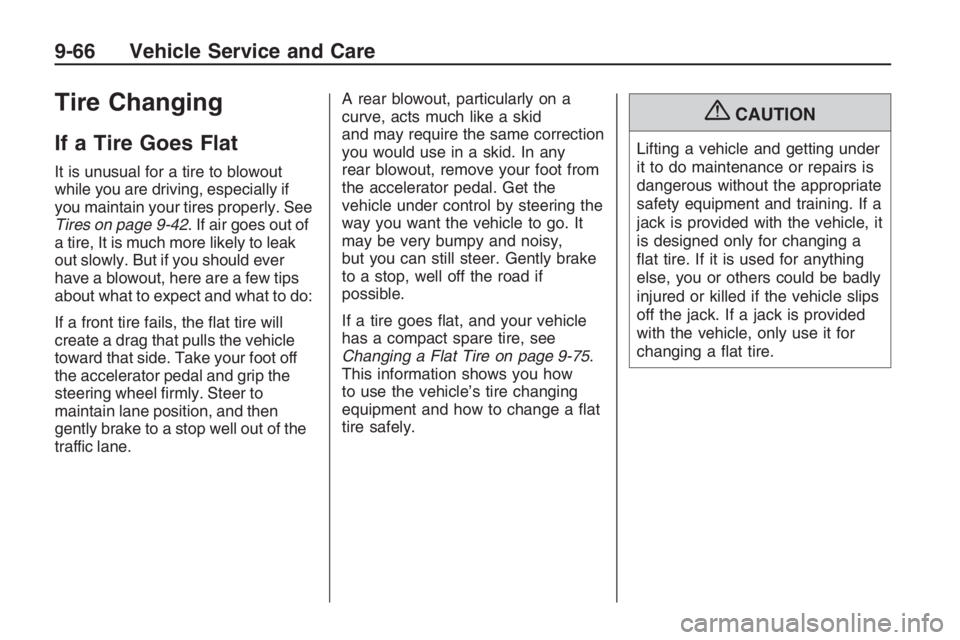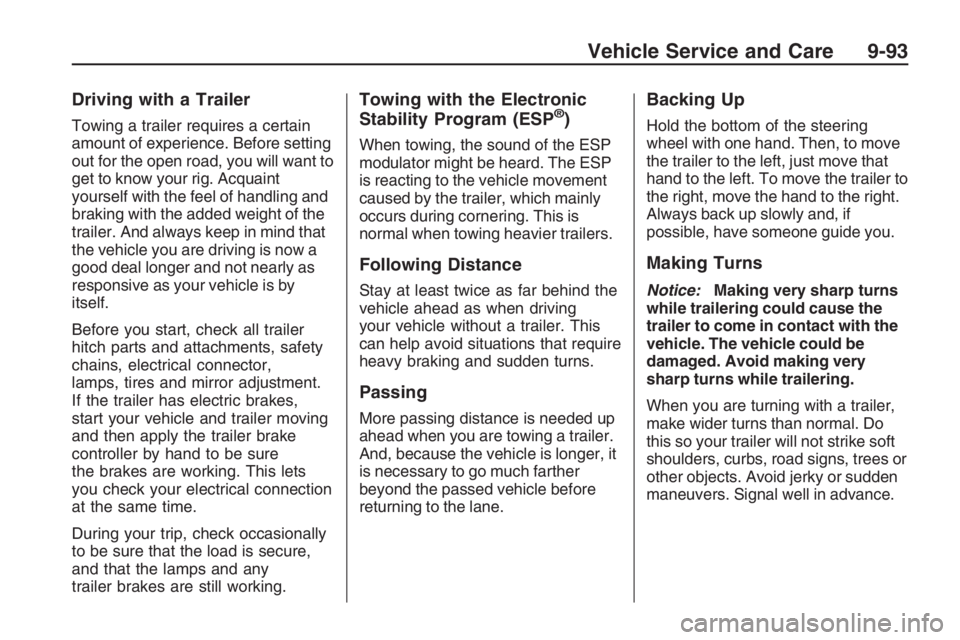2009 PONTIAC G8 steering wheel
[x] Cancel search: steering wheelPage 270 of 356

Tire Changing
If a Tire Goes Flat
It is unusual for a tire to blowout
while you are driving, especially if
you maintain your tires properly. See
Tires on page 9-42. If air goes out of
a tire, It is much more likely to leak
out slowly. But if you should ever
have a blowout, here are a few tips
about what to expect and what to do:
If a front tire fails, the �at tire will
create a drag that pulls the vehicle
toward that side. Take your foot off
the accelerator pedal and grip the
steering wheel �rmly. Steer to
maintain lane position, and then
gently brake to a stop well out of the
traffic lane.A rear blowout, particularly on a
curve, acts much like a skid
and may require the same correction
you would use in a skid. In any
rear blowout, remove your foot from
the accelerator pedal. Get the
vehicle under control by steering the
way you want the vehicle to go. It
may be very bumpy and noisy,
but you can still steer. Gently brake
to a stop, well off the road if
possible.
If a tire goes �at, and your vehicle
has a compact spare tire, see
Changing a Flat Tire on page 9-75.
This information shows you how
to use the vehicle’s tire changing
equipment and how to change a �at
tire safely.
{CAUTION
Lifting a vehicle and getting under
it to do maintenance or repairs is
dangerous without the appropriate
safety equipment and training. If a
jack is provided with the vehicle, it
is designed only for changing a
�at tire. If it is used for anything
else, you or others could be badly
injured or killed if the vehicle slips
off the jack. If a jack is provided
with the vehicle, only use it for
changing a �at tire.
9-66 Vehicle Service and Care
Page 297 of 356

Driving with a Trailer
Towing a trailer requires a certain
amount of experience. Before setting
out for the open road, you will want to
get to know your rig. Acquaint
yourself with the feel of handling and
braking with the added weight of the
trailer. And always keep in mind that
the vehicle you are driving is now a
good deal longer and not nearly as
responsive as your vehicle is by
itself.
Before you start, check all trailer
hitch parts and attachments, safety
chains, electrical connector,
lamps, tires and mirror adjustment.
If the trailer has electric brakes,
start your vehicle and trailer moving
and then apply the trailer brake
controller by hand to be sure
the brakes are working. This lets
you check your electrical connection
at the same time.
During your trip, check occasionally
to be sure that the load is secure,
and that the lamps and any
trailer brakes are still working.
Towing with the Electronic
Stability Program (ESP®)
When towing, the sound of the ESP
modulator might be heard. The ESP
is reacting to the vehicle movement
caused by the trailer, which mainly
occurs during cornering. This is
normal when towing heavier trailers.
Following Distance
Stay at least twice as far behind the
vehicle ahead as when driving
your vehicle without a trailer. This
can help avoid situations that require
heavy braking and sudden turns.
Passing
More passing distance is needed up
ahead when you are towing a trailer.
And, because the vehicle is longer, it
is necessary to go much farther
beyond the passed vehicle before
returning to the lane.
Backing Up
Hold the bottom of the steering
wheel with one hand. Then, to move
the trailer to the left, just move that
hand to the left. To move the trailer to
the right, move the hand to the right.
Always back up slowly and, if
possible, have someone guide you.
Making Turns
Notice:Making very sharp turns
while trailering could cause the
trailer to come in contact with the
vehicle. The vehicle could be
damaged. Avoid making very
sharp turns while trailering.
When you are turning with a trailer,
make wider turns than normal. Do
this so your trailer will not strike soft
shoulders, curbs, road signs, trees or
other objects. Avoid jerky or sudden
maneuvers. Signal well in advance.
Vehicle Service and Care 9-93
Page 317 of 356

Additional Required Services (cont’d)
Service and Miles (Kilometers)25,000
(40 000) 50,000
(80 000) 75,000
(120 000) 100,000
(160 000) 125,000
(200 000) 150,000
(240 000)
Inspect engine accessory drive belt.
An Emission Control Service.
See footnote (g). •
Change brake hydraulic �uid at a
regular maintenance service every
two years. See footnote (m).
Maintenance Footnotes
(a)Visually inspect brake lines and
hoses for proper hook-up, binding,
leaks, cracks, chafing, etc. Inspect
disc brake pads for wear and rotors
for surface condition. Inspect drum
brake linings/shoes for wear or
cracks. Inspect other brake parts,
including drums, wheel cylinders,
calipers, parking brake, etc.
(b) Visually inspect front and rear
suspension and steering system for
damaged, loose, or missing parts
or signs of wear. Inspect power steering lines and hoses for proper
hook-up, binding, leaks, cracks,
chafing, etc.
(c)
Visually inspect hoses and have
them replaced if they are cracked,
swollen, or deteriorated. Inspect all
pipes, fittings and clamps; replace
with genuine parts as needed.
To help ensure proper operation, a
pressure test of the cooling system
and pressure cap and cleaning
the outside of the radiator and
air conditioning condenser is
recommended at least once a year. (d)
Inspect wiper blades for wear,
cracking, or contamination.
Clean the windshield and wiper
blades, if contaminated. Replace
wiper blades that are worn or
damaged. See Windshield Wiper
Blade Replacement on page 9-24
and “Windshield and Wiper Blades”
under Exterior Cleaning on
page 9-98 for more information.
Service and Maintenance 11-7
Page 347 of 356

A
Accessories and
Modi�cations...................... 9-3
Accessory Power Outlets........ 4-9
Adding Equipment to Your
Airbag-Equipped Vehicle....1-32
Additives, Fuel.....................8-36
Add-On Electrical
Equipment.......................9-36
Air Cleaner/Filter, Engine.......9-11
Air Conditioning...............7-1, 7-4
Airbag
Passenger Status
Indicator.......................4-14
Readiness Light................4-13
System, Replacing Parts
After a Crash................1-33
Airbag System.....................1-20
Adding Equipment to Your
Airbag-Equipped
Vehicle........................1-32
Check.............................1-33
How Does an Airbag
Restrain?.....................1-25Airbag System (cont.)
Passenger Sensing
System........................1-27
Servicing Your
Airbag-Equipped
Vehicle........................1-31
What Makes an Airbag
In�ate?........................1-25
What Will You See After
an Airbag In�ates?........1-25
When Should an Airbag
In�ate?........................1-23
Where Are the Airbags?.....1-22
Antenna, Fixed Mast............6-37
Antenna, XM™ Satellite
Radio Antenna System......6-37
Antilock Brake
System (ABS)..................8-18
Antilock Brake, System
Warning Light...................4-16
Appearance Care
Chemical Paint
Spotting.....................9-102
Exterior Cleaning..............9-98Appearance Care (cont.)
Finish Damage...............9-102
Interior Cleaning...............9-95
Sheet Metal Damage.......9-102
Underbody Maintenance . . . 9-102
Appointments, Scheduling
Service...........................12-8
Audio System........................ 6-1
Audio Steering Wheel
Controls.......................6-36
Fixed Mast Antenna..........6-37
Radio Reception...............6-36
Setting the Clock................ 6-2
Theft-Deterrent Feature......6-35
XM™ Satellite Radio
Antenna System............6-37
Audio System(s).................... 6-3
Automatic Climate Control
System............................. 7-4
Automatic Headlamp
System............................. 5-2
Automatic Transmission
Operation.......................... 8-6
INDEX i-1
Page 355 of 356

Spare Tire
Compact.........................9-83
Installing..........................9-77
Removing........................9-76
Storing............................9-82
Speci�cations, Capacities......10-2
Speedometer.......................4-12
Start Vehicle, Remote............. 2-6
Starting the Engine................ 8-4
Steering..............................8-22
Steering Wheel Controls,
Audio..............................6-36
Steering Wheel, Tilt Wheel...... 4-4
Storage Areas
Center Console Storage
Area ............................. 3-1
Convenience Net................ 3-2
Cupholders........................ 3-1
Glove Box......................... 3-1
Stuck in Sand, Mud, Ice, or
Snow ..............................8-29
Sun Visors..........................2-15
Sunroof..............................2-18T
Tachometer.........................4-12
Taillamps............................9-34
Theft-Deterrent, Radio...........6-35
Theft-Deterrent Systems........2-11
Content Theft-Deterrent.....2-13
Immobilizer......................2-11
Immobilizer Operation........2-12
Tilt Wheel............................. 4-4
Time, Setting......................... 6-2
Tire
Pressure Light..................4-17
Tires..................................9-42
Buying New Tires.............9-59
Chains............................9-65
Changing a Flat Tire.........9-75
Compact Spare Tire..........9-83
Different Size...................9-61
High-Speed Operation.......9-51
If a Tire Goes Flat............9-66
In�ation - Tire Pressure.....9-49
Inspection and Rotation.....9-57
Installing the Spare Tire.....9-77Tires (cont.)
Pressure Monitor
Operation.....................9-54
Pressure Monitor
System........................9-52
Removing the Flat Tire......9-77
Removing the Spare
Tire and Tools...............9-76
Storing a Flat or Spare
Tire and Tools...............9-82
Tire Sealant and
Compressor Kit.............9-67
Tire Sidewall Labeling.......9-42
Tire Terminology and
De�nitions....................9-46
Uniform Tire Quality
Grading.......................9-62
Wheel Alignment and
Tire Balance.................9-64
Wheel Replacement..........9-64
When It Is Time for
New Tires....................9-59
INDEX i-9